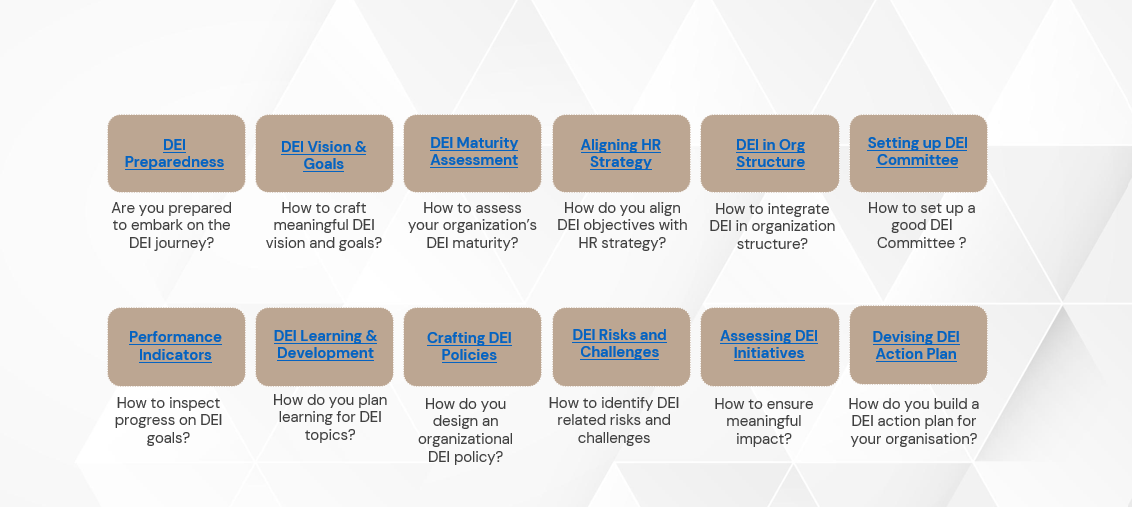In today’s rapidly evolving business landscape, Diversity, Equity, and Inclusion (DEI) have emerged as crucial pillars for organizational success. Beyond being a social imperative, DEI plays a pivotal role in shaping workplace culture, driving innovation, and boosting organizational performance. This blog delves into the DEI toolkit, its core components, and how Indian organizations can effectively integrate these strategies to foster inclusivity and sustainable growth.
What is a DEI Toolkit?
A DEI toolkit is a structured resource designed to assist organizations in creating and nurturing a diverse and inclusive environment. It provides practical frameworks, customizable templates, and proven strategies to assess and enhance DEI initiatives within the workplace. Serving as a step-by-step guide, the toolkit empowers organizations to embed inclusivity into their culture, policies, and practices.

Key Components of a DEI Toolkit
- Assessment Tools: Evaluate the current state of diversity and inclusion, identifying strengths and areas for growth.
- Implementation Strategies: Detailed guidelines to design and execute DEI initiatives effectively.
- Training Resources: Modules and materials to educate employees and leaders about DEI principles.
- Metrics and Reporting Tools: Methods to track, analyze, and report progress on goals.
Benefits of DEI Compliance
The adoption of a robust DEI framework benefits organizations in multiple ways:
1. Enhanced Organizational Image
Organizations championing DEI are perceived as progressive and socially responsible. This not only attracts top-tier talent but also strengthens employer branding. For instance, Tata Consultancy Services (TCS) has gained recognition for its commitment to gender diversity, significantly enhancing its ability to attract and retain diverse talent.
2. Boosted Innovation
Diverse teams bring unique perspectives, fueling creativity and innovation. Research by McKinsey highlights that companies with higher diversity levels are 35% more likely to outperform competitors in profitability.
3. Elevated Employee Engagement
A workplace where employees feel valued and included fosters higher levels of engagement, productivity, and satisfaction. Infosys, for example, has cultivated an inclusive culture that has resulted in improved employee morale and retention.
4. Legal Risk Mitigation
A well-structured framework reduces the likelihood of discrimination or harassment-related legal issues. It creates a safe, inclusive environment, protecting organizations from reputational and financial harm.
5. Social Responsibility
DEI goes beyond business—it contributes to societal progress. Companies like Mahindra Group have driven impactful community initiatives, empowering marginalized sections of society and promoting equitable growth.
Implementing the Toolkit in Indian Organizations
Successful implementation of a toolkit requires a strategic approach tailored to the organization’s unique needs:
- Assess Current State
Utilize the toolkit’s assessment tools to understand where your organization stands in terms of diversity and inclusion. Identify gaps and opportunities for improvement. - Set Clear Goals
Establish measurable DEI objectives. For instance, increasing the percentage of women in leadership roles from 20% to 30% within three years is a tangible target. - Craft a Comprehensive Strategy
Develop an actionable plan encompassing recruitment, training, and policy formulation to create an inclusive work culture. - Engage Leadership
Top management commitment is essential. Leadership buy-in ensures DEI initiatives receive the necessary support and resources. - Monitor Progress
Regularly evaluate the impact of DEI efforts using metrics like employee surveys, retention rates, and representation statistics. - Promote Open Communication
Encourage transparent discussions around DEI to foster a sense of belonging and mutual respect among employees. - Celebrate Milestones
Recognize and reward progress to keep employees motivated and invested in the DEI journey.
Real-World Examples in Action
1. Wipro’s Gender Diversity Goals
Wipro is working toward achieving gender parity by 2025, with dedicated initiatives to recruit and mentor women in tech roles.
2. Cognizant’s LGBTQ+ Inclusion
Cognizant has introduced policies supporting same-sex partners and launched programs to create a welcoming environment for LGBTQ+ employees.
3. HDFC Bank’s Women Empowerment Initiatives
HDFC Bank supports women entrepreneurs through skill-building programs, fostering economic inclusivity and community development.
Conclusion
Incorporating Diversity, Equity, and Inclusion into the core of organizational strategy is no longer optional—it’s essential for long-term success. A well-designed toolkit enables organizations to navigate this journey effectively, driving internal growth while contributing to societal progress.
As Indian companies embrace DEI principles, they not only build stronger, more innovative teams but also create a positive impact on the communities they serve. By staying committed to continuous improvement, organizations can ensure a future where inclusivity and equity are the norm.
Let’s Make a Difference

